light CITROEN C6 2012 Handbook (in English)
[x] Cancel search | Manufacturer: CITROEN, Model Year: 2012, Model line: C6, Model: CITROEN C6 2012Pages: 216, PDF Size: 10.23 MB
Page 63 of 216
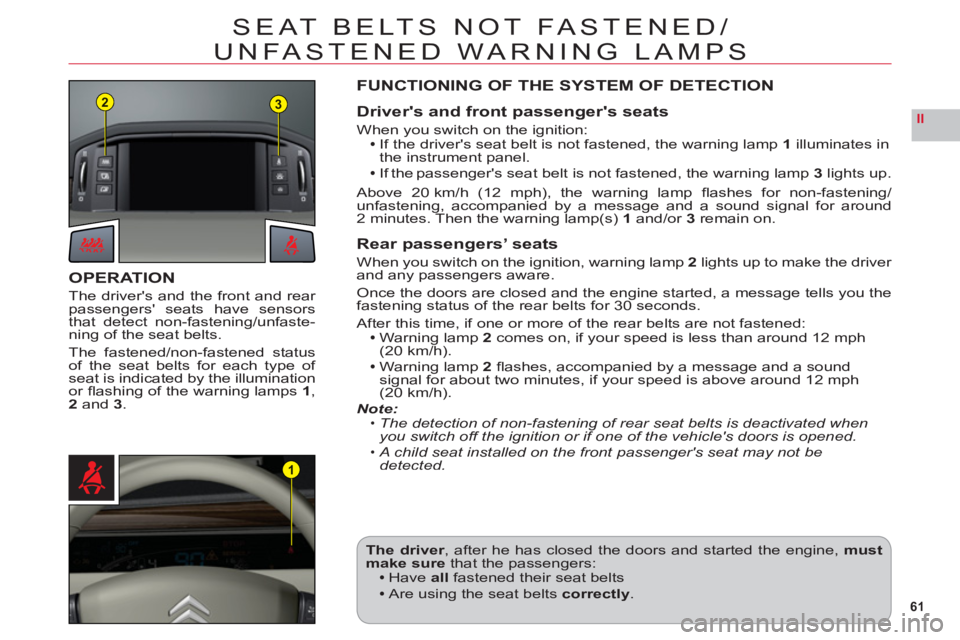
61
II
23
1
SEAT BELTS NOT FASTENED/
UNFASTENED WARNING LAMPS
OPERATION
The driver's and the front and rear passengers' seats have sensors
that detect non-fastening/unfaste-ning of the seat belts.
The fastened
/non-fastened status
of the seat belts for each type of seat is indicated by the illumination
or fl ashing of the warning lamps 1,2 and 3.
FUNCTIONING OF THE SYSTEM OF DETECTION
Driver's and front passenger's seats
When you switch on the ignition:If the driver's seat belt is not fastened, the warning lamp 1 illuminates in
the instrument panel.
If the passenger's seat belt is not fastened, the warning lamp 3 lights up.
Above 20 km
/h (12 mph), the warning lamp fl ashes for non-fastening/ unfastening, accompanied by a message and a sound signal for around
2 minutes. Then the warning lamp(s) 1 and/or 3 remain on.
Rear passengers’ seats
When you switch on the ignition, warning lamp2lights up to make the driver
and any passengers aware.
Once the doors are closed and the engine started, a message tells you thefastening status of the rear belts for 30 seconds.
A
fter this time, if one or more of the rear belts are not fastened:Warning lamp 2comes on, if your speed is less than around 12 mph (20 km/h).Warning lamp 2fl ashes, accompanied by a message and a sound signal for about two minutes, if your speed is above around 12 mph (20 km/h).Note:The detection of non-fastening of rear seat belts is deactivated whenyou switch off the ignition or if one of the vehicle's doors is opened.
A child seat installed on the front passenger's seat may not bedetected.
•
•
The driver, after he has closed the doors and started the engine,mustmake sure that the passengers:Have allfastened their seat belts
Are using the seat belts correctly.
Page 64 of 216
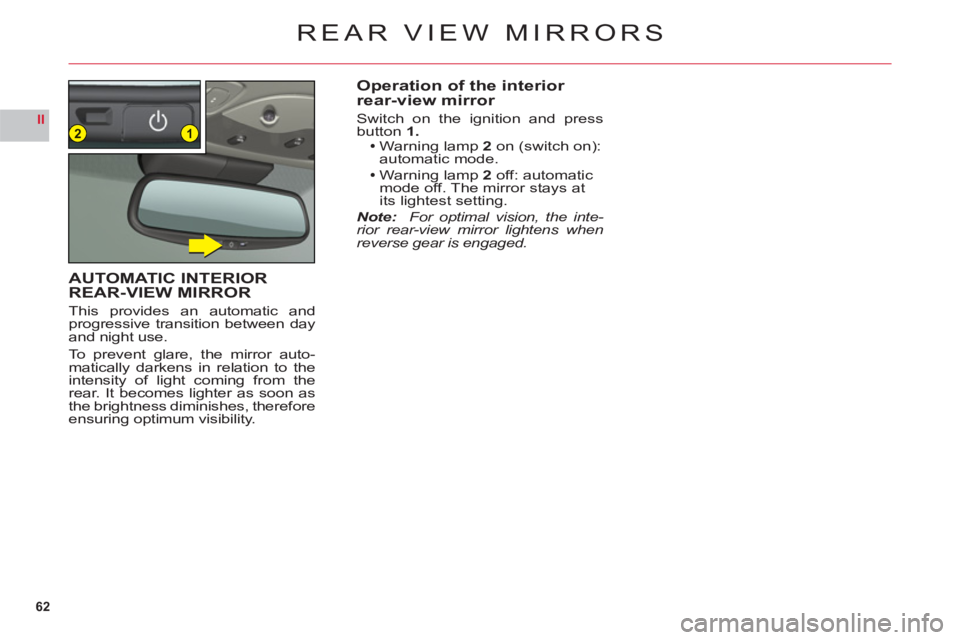
62
II12
REAR VIEW MIRRORS
Operation of the interior
rear-view mirror
Switch on the ignition and press button1.Warning lamp 2on (switch on):automatic mode.Warning lamp 2off: automaticmode off. The mirror stays at
its lightest setting.Note: For optimal vision, the inte-rior rear-view mirror lightens when reverse gear is engaged.
AUTOMATIC INTERIORREAR-VIEW MIRROR
This provides an automatic andprogressive transition between dayand night use.
To prevent glare, the mirror auto-matically darkens in relation to the
intensity of light coming from therear. It becomes lighter as soon as
the brightness diminishes, thereforeensuring optimum visibility.
Page 70 of 216
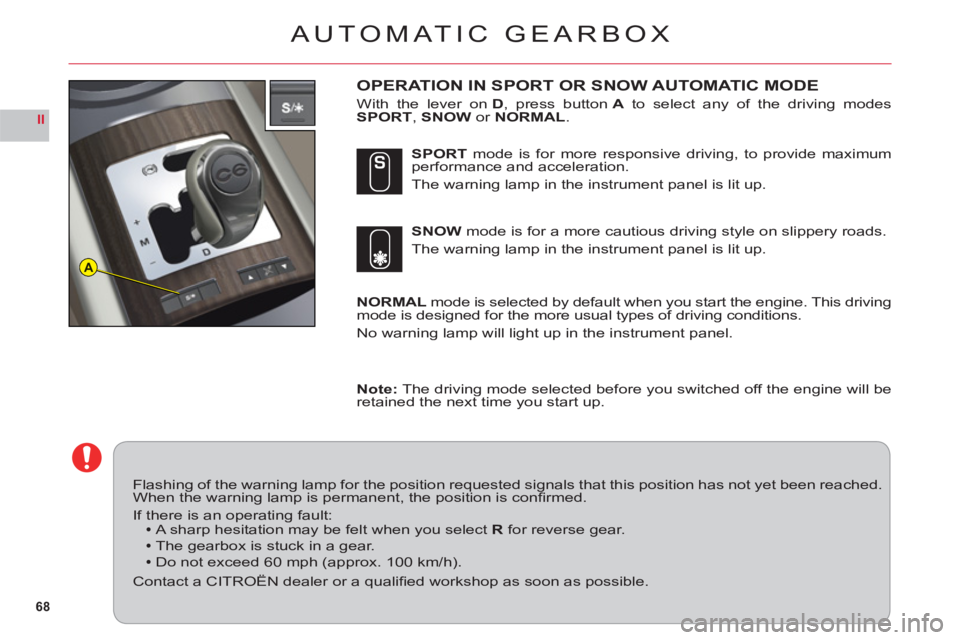
68
II
A
AUTOMATIC GEARBOX
OPERATION IN SPORT OR SNOW AUTOMATIC MODE
With the lever on D, press button Ato select any of the driving modesSPORT,SNOW or NORMAL.
NORMAL mode is selected by default when you start the engine. This drivingmode is designed for the more usual types of driving conditions.
No warnin
g lamp will light up in the instrument panel. SNO
W mode is for a more cautious driving style on slippery roads.
The warning lamp in the instrument panel is lit up. SPOR
T mode is for more responsive driving, to provide maximumperformance and acceleration.
The warnin
g lamp in the instrument panel is lit up.
Note
: The driving mode selected before you switched off the engine will be
retained the next time you start up.
Flashing of the warning lamp for the position requested signals that this position has not yet been reached.When the warning lamp is permanent, the position is confi rmed.
If there is an operating fault:A sharp hesitation may be felt when you selectR for reverse gear.The gearbox is stuck in a gear.
Do not exceed 60 mph (approx. 100 km/h).
Contact a CITROËN dealer or a qualifi ed workshop as soon as possible.
Page 71 of 216

69
II
13
24
A
C
CRUISE CONTROL
SELECTION OF CRUISE CONTROL
This driving assistance function
allows you to drive at the speed of your choice without the need to
action the accelerator.
Cruise control is available inthehigher gears only, for speedsgreater than 24 mph (40 km/h).Note:Information relating to thecruise control is displayed inzone Aof your instrument panel.To activate cruise control, press button
1to display in zoneAof your instrument panel the symbolCfor cruise control.
The cruise speed is then memorised. The cruise speed will
be displayed in zone Ain the instrument panel. At the time
you select the function, no cruise speed hasyet been memorised.
TO SELECT A CRUISE SPEED
Accelerate to the desired speed, then give a short press on button 3 or button4.
You can then release the accelerator pedal. The vehicle will automaticallykeep to that chosen speed.Note: The vehicle speed may vary slightly from that memorised.
Temporary override of the cruise speed
While cruise control is in operation, it is always possible to go above thecruise speed simply by pressing the accelerator pedal (for example to over-
take another vehicle). The speed displayed fl ashes. You have only to release
the accelerator pedal to return to your cruise speed.Note: If during cruise control the system cannot keep to the cruise speed (e.g. on a steep descent), then the speed fl ashes. If necessary, brake to
curb your speed.
Page 73 of 216

71
II
13
24
A
B
SPEED LIMITER
SELECTION OF THE SPEED LIMITER
To select the speed limiter, press on button 1 to display inzoneA of your instrument panel the symbol Bfor the speed
limiter.
The last speed memorised is also displayed.
TO ADJUST THE MAXIMUM SPEED
Provided the engine is running, you can select your maximum speed, with
short or long presses on:Button3to increase the speed orButton4to decrease the speed.
Remark:
Successive presses will allow to modify the speed in steps of 1 mph (1 km/h)and a continuous press in steps of 3 mph (5 km/h).
ACTIVATION OF THE MAXIMUM SPEED
When the desired maximum speed is displayed, press button2 to activatethe speed limiter.
The information "OFF" then disappears from the screen.
As long as the function is active, action on the accelerator pedal will not per-
mit the programmed speed to be exceeded, unless you press the pedal hard
down to activate the switch at the end of its travel. See "Temporary overrideof the maximum speed".Note: The vehicle speed may slightly exceed the memorised maximumspeed. This drivin
g assistance functionenables you to select a maximumspeed that you wish not to exceed.This must be greater than 18 mph(30 km/h).Note:The information relating tothe limiter is displayed in zone Aof the instrument panel.
Page 75 of 216
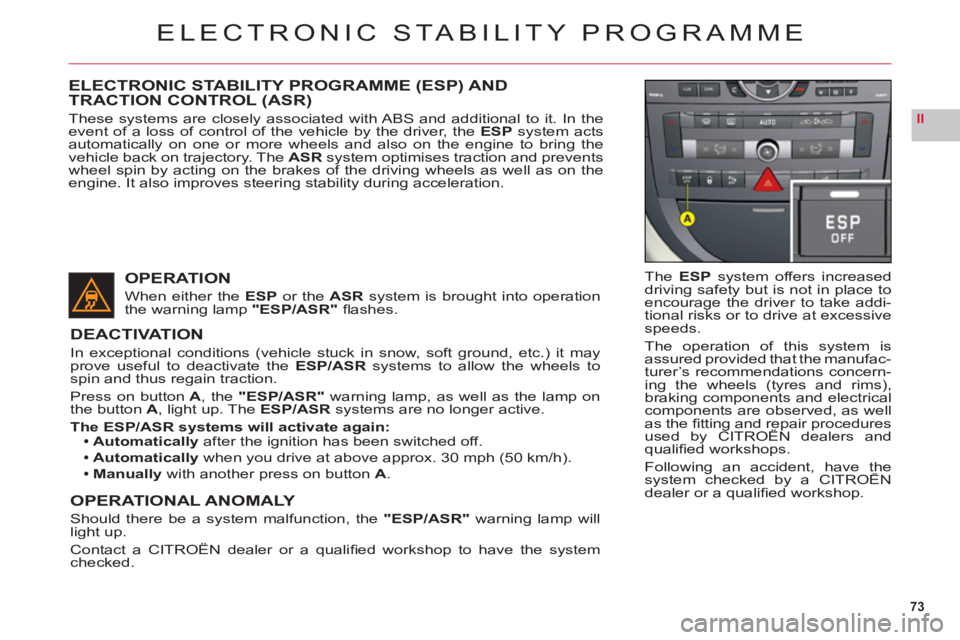
73
II
ELECTRONIC STABILITY PROGRAMME
TheESP system offers increased
driving safety but is not in place toencourage the driver to take addi-
tional risks or to drive at excessivespeeds.
The operation of this s
ystem is
assured provided that the manufac-
turer’s recommendations concern-
ing the wheels (tyres and rims),
braking components and electricalcomponents are observed, as wellas the fi tting and repair proceduresused by CITROËN dealers andgpp
qualifi ed workshops.
Following an accident, have thesystem checked by a CITROËNg,
dealer or a qualifi ed workshop.
ELECTRONIC STABILITY PROGRAMME (ESP) AND TRACTION CONTROL (ASR)
These systems are closely associated with ABS and additional to it. In the event of a loss of control of the vehicle by the driver, theESPsystem acts
automatically on one or more wheels and also on the engine to bring the
vehicle back on trajectory. The ASRsystem optimises traction and prevents
wheel spin by acting on the brakes of the driving wheels as well as on the engine. It also improves steering stability during acceleration.
OPERATION
When either the ESPor the ASR system is brought into operation
the warning lamp "ESP/ASR" fl ashes.
DEACTIVATION
In exceptional conditions (vehicle stuck in snow, soft ground, etc.) it mayprove useful to deactivate theESP/ASR systems to allow the wheels tospin and thus regain traction.
Press on buttonA, the"ESP/ASR" warning lamp, as well as the lamp on
the buttonA, light up. TheESP/ASR systems are no longer active.
The ESP/ASR systems will activate again:Automatically after the ignition has been switched off.
Automatically when you drive at above approx. 30 mph (50 km/h).
Manuallywith another press on button A.
OPERATIONAL ANOMALY
Should there be a system malfunction, the "ESP/ASR"warning lamp willlight up.
Contact a CITROËN dealer or a qualifi ed workshop to have the systemchecked.
Page 76 of 216
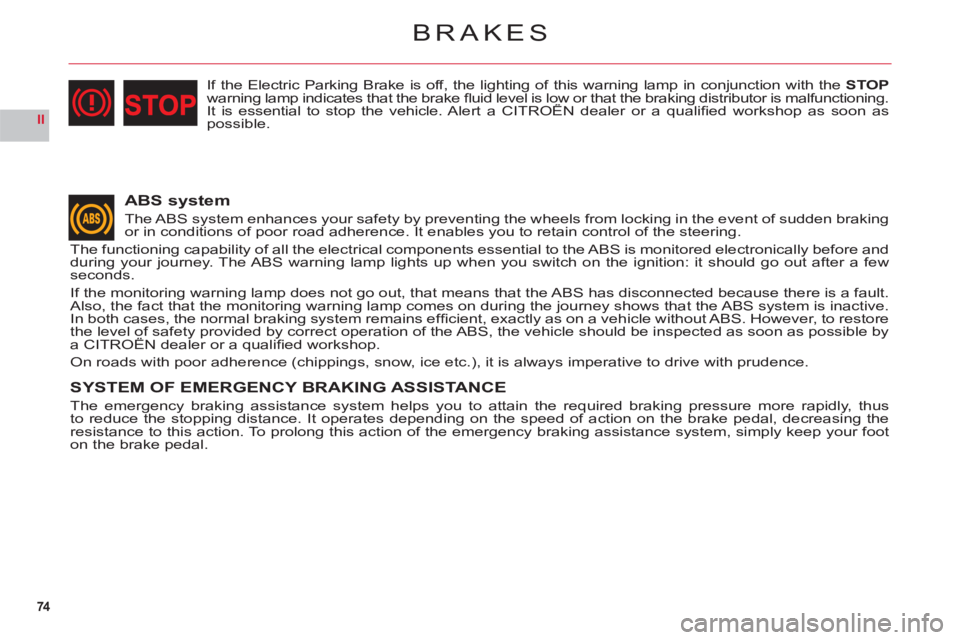
74
II
BRAKES
ABS system
The ABS system enhances your safety by preventing the wheels from locking in the event of sudden brakingor in conditions of poor road adherence. It enables you to retain control of the steering.
The
functioning capability of all the electrical components essential to the ABS is monitored electronically before and
during your journey. The ABS warning lamp lights up when you switch on the ignition: it should go out after a fewseconds.
If the monitoring warning lamp does not go out, that means that the ABS has disconnected because there is a fault.Also, the fact that the monitoring warning lamp comes on during the journey shows that the ABS system is inactive.
In both cases, the normal braking system remains effi cient, exactly as on a vehicle without ABS. However, to restorethe level of safety provided by correct operation of the ABS, the vehicle should be inspected as soon as possible bya CITROÀN dealer or a qualifi ed workshop.yp y p
On roads with poor adherence (chippings, snow, ice etc.), it is always imperative to drive with prudence.
SYSTEM OF EMERGENCY BRAKING ASSISTANCE
The emergency braking assistance system helps you to attain the required braking pressure more rapidly, thus
to reduce the stopping distance. It operates depending on the speed of action on the brake pedal, decreasing theresistance to this action. To prolong this action of the emergency braking assistance system, simply keep your foot
on the brake pedal.
If the Electric Parking Brake is off, the lighting of this warning lamp in conjunction with the STOPwarning lamp indicates that the brake fl uid level is low or that the braking distributor is malfunctioning.It is essential to stop the vehicle. Alert a CITROËN dealer or a qualifi ed workshop as soon asgpgg
possible.
Page 78 of 216
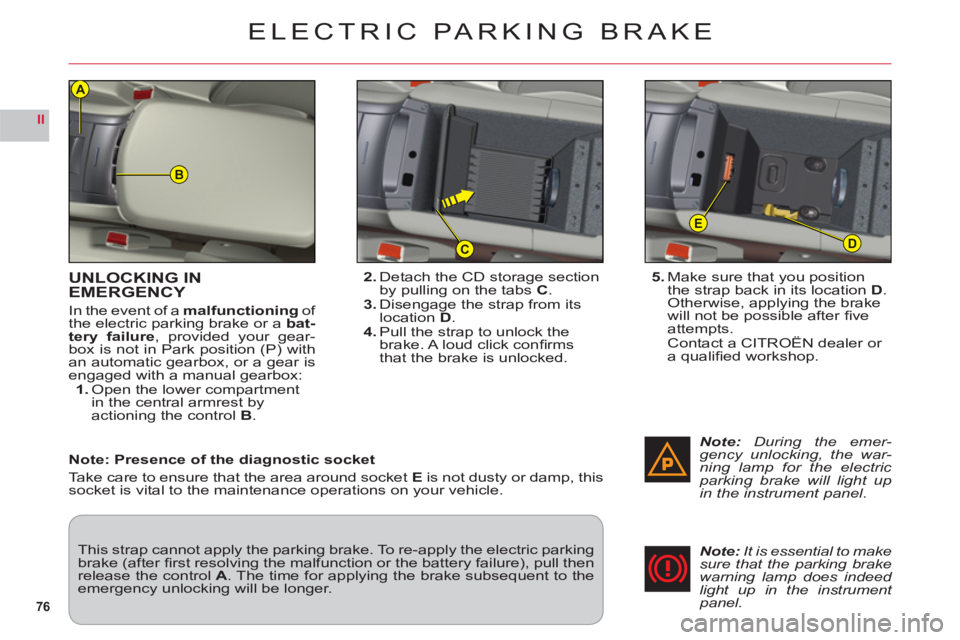
76
II
B
D
E
C
A
UNLOCKING INEMERGENCY
In the event of a malfunctioningof
the electric parking brake or a bat-
tery failure, provided your gear-
box is not in Park position (P) with
an automatic gearbox, or a gear isengaged with a manual gearbox:1.Open the lower compartmentin the central armrest by
actioning the control B.
ELECTRIC PARKING BRAKE
5. Make sure that you position
the strap back in its locationD.Otherwise, applying the brake
will not be possible after fi ve
attempts.Contact a CITROÀN dealer or
a qualifi ed workshop.
This strap cannot apply the parking brake. To re-apply the electric parking brake (after fi rst resolving the malfunction or the battery failure), pull then release the control A. The time for applying the brake subsequent to the emergency unlocking will be longer.
Note:During the emer-gency unlocking, the war-ning lamp for the electric parking brake will light upin the instrument panel.
2.Detach the CD storage sectionby pulling on the tabsC.3. Disengage the strap from itslocationD.4.Pull the strap to unlock the brake. A loud click confi rmsthat the brake is unlocked.
Note: It is essential to makesure that the parking brakewarning lamp does indeed light up in the instrument panel. Note: Presence of the dia
gnostic socket
Take care to ensure that the area around socket Eis not dusty or damp, this socket is vital to the maintenance operations on your vehicle.
Page 81 of 216
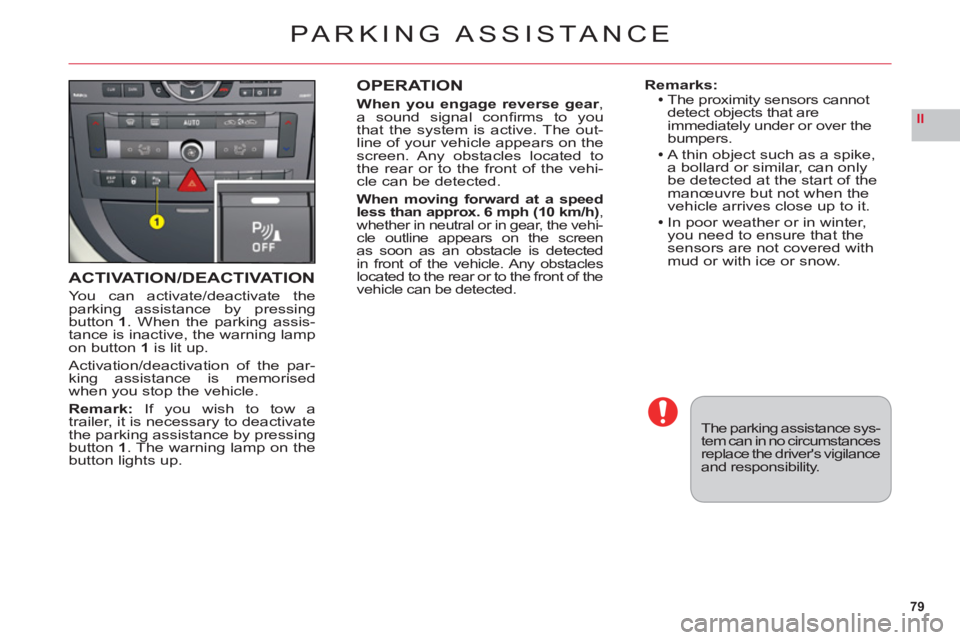
79
II
ACTIVATION/DEACTIVATION
You can activate/deactivate theparking assistance by pressingbutton 1. When the parking assis-
tance is inactive, the warning lampon button1is lit up.
Activation/deactivation of the par-king assistance is memorisedwhen you stop the vehicle.
Remark: If you wish to tow a
trailer, it is necessary to deactivate
the parking assistance by pressing
button 1. The warning lamp on the
button lights up.
OPERATION
When you engage reverse gear,
a sound signal confi rms to you
that the system is active. The out-line of your vehicle appears on the
screen. Any obstacles located to
the rear or to the front of the vehi-cle can be detected.
When moving forward at a speed less than approx. 6 mph (10 km/h),
whether in neutral or in gear, the vehi-cle outline appears on the screen as soon as an obstacle is detected
in front of the vehicle. Any obstacles located to the rear or to the front of the
vehicle can be detected.
Remarks:The proximity sensors cannot
detect objects that are
immediatel
y under or over the
bumpers.
A thin object such as a spike,
a bollard or similar, can only be detected at the start of themanœuvre but not when the
vehicle arrives close up to it.
In poor weather or in winter,you need to ensure that the sensors are not covered with
mud or with ice or snow.
PARKING ASSISTA NCE
The parking assistance sys-tem can in no circumstancesreplace the driver's vigilanceand responsibility.
Page 82 of 216
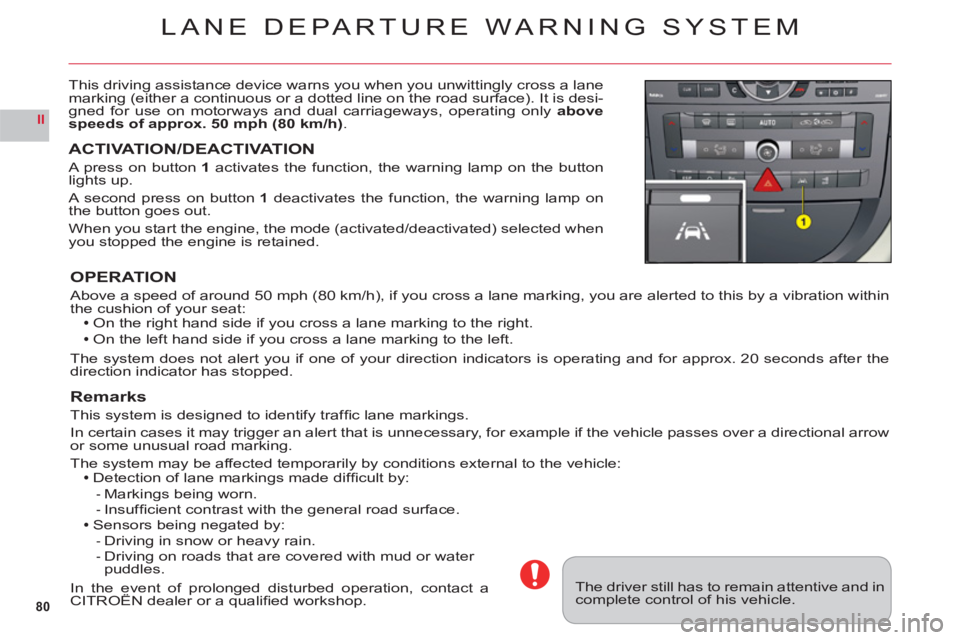
80
II
LANE DEPARTURE WARNING SYSTEM
This driving assistance device warns you when you unwittingly cross a lane marking (either a continuous or a dotted line on the road surface). It is desi-gned for use on motorways and dual carriageways, operating onlyabove
speeds of approx.50 mph (80 km/h).
ACTIVATION/DEACTIVATION
A press on button 1activates the function, the warning lamp on the button lights up.
A second press on button 1 deactivates the function, the warning lamp on
the button goes out.
When you start the engine, the mode (activated/deactivated) selected when you stopped the engine is retained.
OPERATION
Above a speed of around 50 mph (80 km/h), if you cross a lane marking, you are alerted to this by a vibration within
the cushion of your seat:On the right hand side if you cross a lane marking to the right.
On the left hand side if you cross a lane marking to the left.
The system does not alert you if one of your direction indicators is operating and for approx. 20 seconds after the
direction indicator has stopped.
Remarks
This system is designed to identify traffi c lane markings.
In certain cases it ma
y trigger an alert that is unnecessary, for example if the vehicle passes over a directional arrow
or some unusual road marking.
The system may be affected temporarily by conditions external to the vehicle:Detection of lane markings made diffi cult by:
Markings being worn.Insuffi cient contrast with the general road surface.Sensors being negated by:
Driving in snow or heavy rain.Driving on roads that are covered with mud or water puddles.
In the event of prolonged disturbed operation, contact aCITROÀN dealer or a qualifi ed workshop.pg p
--
--
The driver still has to remain attentive and in complete control of his vehicle.